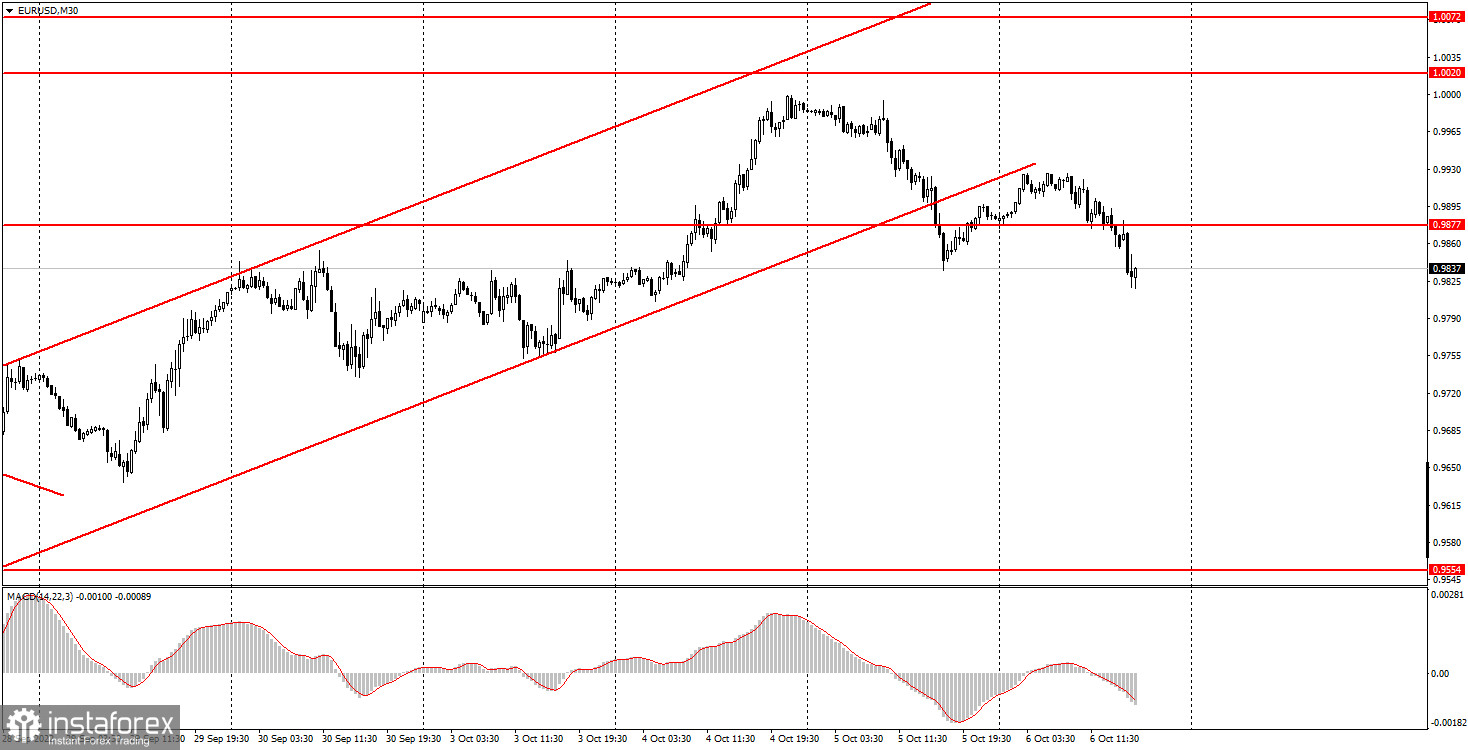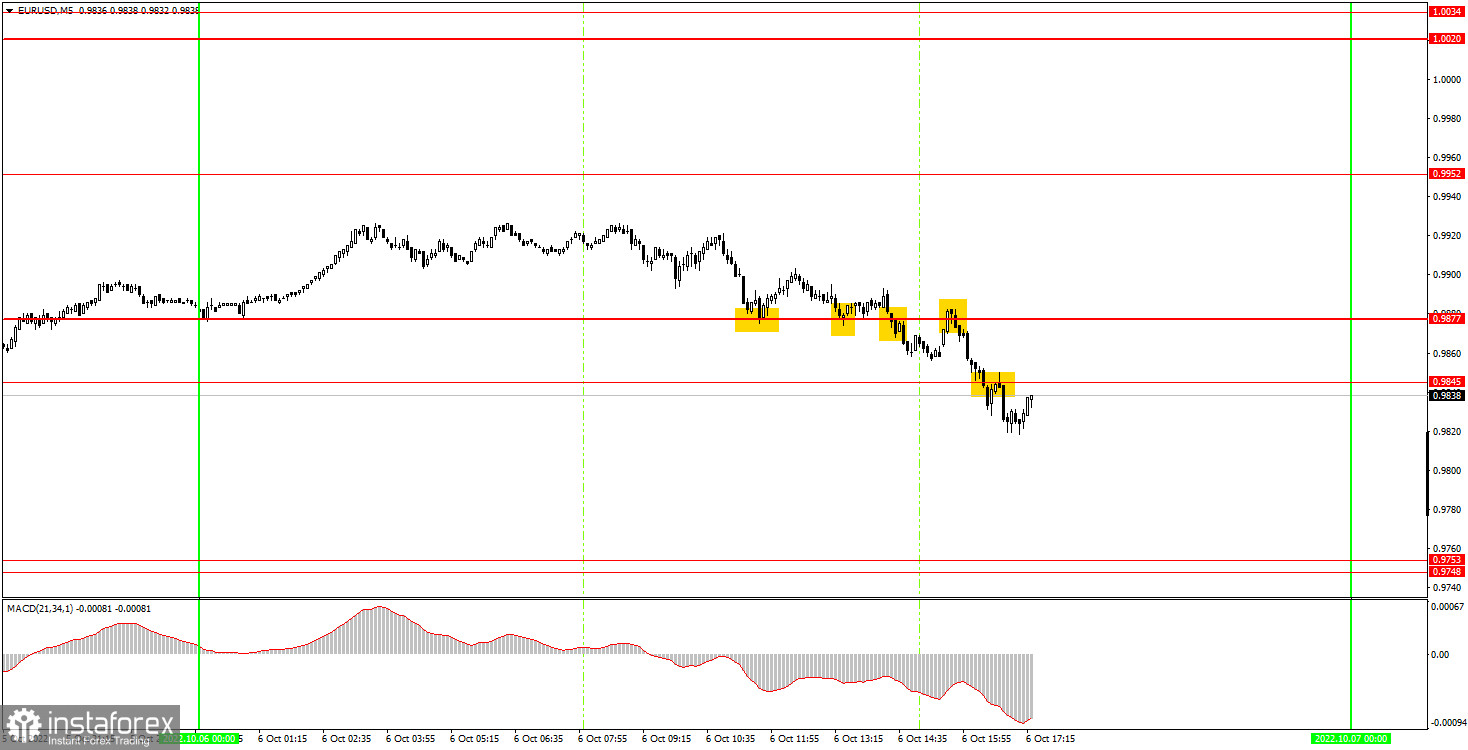Analysis of Thursday's deals:
30M chart of the EUR/USD pair

The EUR/USD currency pair on Thursday, after a slight rollback up, resumed its downward movement after overcoming the ascending channel a day earlier. Thus, as we can see, our assumption about the readiness of the euro to resume its fall is still coming true. Of course, the fall on Thursday was not too strong, but it should be remembered that today there were no macroeconomic statistics (important) either in the European Union or in the US. The EU retail sales report showed a 0.3% contraction in August, which was roughly in line with forecasts. Thus, the fall of the euro may be purely technical in the next few days. However, on Friday everything will depend on the reports on Nonfarm and unemployment in the US. Recall that these data are important not only in themselves, they also largely determine the monetary policy of the Federal Reserve. If the labor market in America begins to experience serious problems, then this may be the basis for reducing the pace of rate hikes, which, in turn, is bad for the US dollar. But this is only purely theoretical. In practice, we believe the Fed will meet its target of a further 1.25% rate hike during the remaining two meetings in 2022.
5M chart of the EUR/USD pair

There were a sufficient number of trading signals on the 5-minute timeframe on Thursday, and the volatility of the day is currently more than 100 points. Unfortunately, it was not possible to catch the beginning of the movement, and several signals were formed near the level of 0.9877 at once. Let's figure out how to proceed. The first buy signal turned out to be false, but the price did not manage to go up even 15 points after its formation. Thus, a long position should have been opened, but during the second signal, it should have been held open. When a sell signal was formed - consolidating below 0.9877, this position should have been closed and shorts opened. The fourth sell signal is a dubbing of the third one. Only after that the pair continued to move down and overcame the level of 0.9845. Below this level, short positions should have been closed manually. Profit was about 35 points. The loss on the first trade is about 25.
How to trade on Friday:
The pair left the ascending channel on the 30-minute timeframe, having spent about a week in it. Thus, we can observe the continuation of the downward movement on Friday, if this is not prevented by statistics from overseas. To do this, it must be positive, or at least not worse than forecasts. In general, the probability of a new fall in the euro is now assessed as quite high. On the 5-minute TF on Friday it is recommended to trade at the levels of 0.9636, 0.9636, 0.9748-0.9753, 0.9845, 0.9877, 0.9952, 1.0020-1.0034, 1.0072. When passing 15 points in the right direction, you should set Stop Loss to breakeven. There will be nothing interesting in the European Union, but at least two reports will be released in the US - on unemployment and Nonfarm - which can provoke a serious market reaction. Therefore, traders will focus on them.
Basic rules of the trading system:
1) The signal strength is calculated by the time it took to form the signal (bounce or overcome the level). The less time it took, the stronger the signal.
2) If two or more deals were opened near a certain level based on false signals (which did not trigger Take Profit or the nearest target level), then all subsequent signals from this level should be ignored.
3) In a flat, any pair can form a lot of false signals or not form them at all. But in any case, at the first signs of a flat, it is better to stop trading.
4) Trade deals are opened in the time period between the beginning of the European session and until the middle of the US one, when all deals must be closed manually.
5) On the 30-minute TF, using signals from the MACD indicator, you can trade only if there is good volatility and a trend, which is confirmed by a trend line or a trend channel.
6) If two levels are located too close to each other (from 5 to 15 points), then they should be considered as an area of support or resistance.
On the chart:
Support and Resistance Levels are the Levels that serve as targets when buying or selling the pair. You can place Take Profit near these levels.
Red lines are the channels or trend lines that display the current trend and show in which direction it is better to trade now.
The MACD indicator (14,22,3) consists of a histogram and a signal line. When they cross, this is a signal to enter the market. It is recommended to use this indicator in combination with trend lines (channels and trend lines).
Important speeches and reports (always contained in the news calendar) can greatly influence the movement of a currency pair. Therefore, during their exit, it is recommended to trade as carefully as possible or exit the market in order to avoid a sharp price reversal against the previous movement.
Beginners on Forex should remember that not every single trade has to be profitable. The development of a clear strategy and money management are the key to success in trading over a long period of time.
 English
English 
 Русский
Русский Bahasa Indonesia
Bahasa Indonesia Bahasa Malay
Bahasa Malay ไทย
ไทย Español
Español Deutsch
Deutsch Български
Български Français
Français Tiếng Việt
Tiếng Việt 中文
中文 বাংলা
বাংলা हिन्दी
हिन्दी Čeština
Čeština Українська
Українська Română
Română

